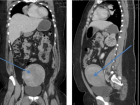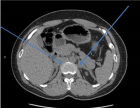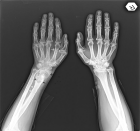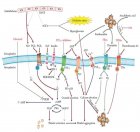Abstract
Case Report
Diagnostic imaging in congenital adrenal hyperplasia – how does it help?
Gul Bano*, Claudette Phillips, Sarah Tang, Anup Sharma and Nigel Beharry
Published: 29 April, 2020 | Volume 4 - Issue 1 | Pages: 007-010
The phenotypic manifestation of congenital adrenal hyperplasia (CAH) is variable, and this largely depends on the extent of 21-Hydroxylase enzyme deficiency. In non- classic CAH (NCCAH), the clinical features predominantly reflect the androgen excess rather than adrenal insufficiency. In boys, the condition may not present until much later in childhood, where the diagnosis is made following presentation with precocious puberty, features of aldosterone insufficiency, or this condition may be detected during fertility workup Imaging is generally not used in the evaluation of CAH, but may be helpful for the diagnosis, management, and follow-up of these patients. CAH can result in adrenal enlargement in both classic and non-classic forms of adrenal hyperplasia. The so-called adrenal rest tissue may be seen at several sites throughout the body, including the celiac plexus region, broad ligaments, normal ovaries, and testes. Sustained elevation of adrenocorticotropic hormone (ACTH) in patients with CAH has been postulated to cause adrenal rest cells to grow and become functionally active. The discovery of bilateral adrenal enlargement during radiologic evaluation for unrelated disease processes might serve as a mode of presentation for clinically not apparent or non- classical congenital adrenal hyperplasia (NCCAH).
Read Full Article HTML DOI: 10.29328/journal.acem.1001013 Cite this Article Read Full Article PDF
References
- Huynh T, McGown I, Cowley D, Nyunt O, Leong GM, et al. The clinical and biochemical spectrum of congenital adrenal hyperplasia secondary to 21- hydroxylase deficiency. Clin Biochem Rev 2009; 30: 75-86. PubMed: https://www.ncbi.nlm.nih.gov/pubmed/19565027
- Khalid JM, Oerton JM, Dezateux C, Hindmarsh PC, Kelnar CJ, et al. Incidence and clinical features of congenital adrenal hyperplasia in Great Britain. Arch Dis Child. 2012; 97: 101-106. PubMed: https://www.ncbi.nlm.nih.gov/pubmed/22241917
- Kanaka GC, Chrousos GP, Dacou VC. The spectrum of clinical, hormonal and molecular findings in 280 individuals with nonclassical congenital adrenal hyperplasia caused by mutations of the CYP21A2 gene. Clin Endocrinol (Oxf). 2015; 82: 543-549. PubMed: https://www.ncbi.nlm.nih.gov/pubmed/25041270
- Avilal NA, Premkumar A, Merke DP. TesticularAdrenal RestTissue in Congenital Adrenal Hyperplasia: Comparison of MR Imaging and Sonographic Findings. AJR. 1999; 172: 1003-1006. PubMed: https://www.ncbi.nlm.nih.gov/pubmed/10587136
- White PC, Speiser PW. Congenital Adrenal Hyperplasia due to21-Hydroxylase Deficiency. Endocrine Reviews. 2000; 21: 245-291. PubMed: https://www.ncbi.nlm.nih.gov/pubmed/28450075
- Witchel SM, Azziz R. Nonclassic Congenital Adrenal Hyperplasia. Int J Pediatr Endocrinol. 2010; 2010: 625105.
- Georgitis WJ. Clinically Silent Congenital Adrenal Hyperplasia Masquerading as Ectopic Adrenocorticotropic Hormone syndrome. The American Journal of Medicine. 1986; 80: 703-708. PubMed: https://www.ncbi.nlm.nih.gov/pubmed/3008554
- Teixeira SR, Elias PL, Andrade MS, Melo AF, Elias JJ. The role of imaging in congenital adrenal hyperplasia. Arq Bras Endocrinol Metab. 2014; 58: 702-708. PubMed: https://www.ncbi.nlm.nih.gov/pubmed/25372578
- Souverijns G, Peene P, Keuleers H, Vanbockrijck M. Ectopic localization of adrenal cortex. European Radiology, 2000; 10: 1165-1168.
- Tajima T, Funakoshi A, Ikeda Y, Hachitanda Y, Yamaguchi M, et al. Nonfunctioning adrenal rest tumour of the liver: radiologic appearance. J Comput Assist Tomogr. 2001; 25: 98-101. PubMed: https://www.ncbi.nlm.nih.gov/pubmed/11176302
- Kepes JJ, O’Boynick P, Jones S, Baum D, McMillan J. Adrenocortical adenoma in the spinal canal of an 8-year old girl. Am J Surg Pathol 1990; 14: 481-484. PubMed: https://www.ncbi.nlm.nih.gov/pubmed/2327553
- Val P, Jeays-Ward K, Swain A. Identification of a novel population of adrenal-like cells in the mammalian testis. Developmental Biology 2006; 299: 250-256. PubMed: https://www.ncbi.nlm.nih.gov/pubmed/16949566
- Wilkins L, Fleishmann W, Howard JE. Macrogenitosomia precox associated with hyperplasia of the androgenic tissue of the adrenal and death from corticoadrenal insufficiency. Endocrinology. 1940; 26: 385-395.
- Claahsen-van der Grinten HL, Hermus ARMM, Otten BJ. Testicular Adrenal Rest Tumours in Congenital Adrenal Hyperplasia. International Journal of Pediatric Endocrinology. 2009; 2009: 624823.
- Claahsen-van der Grinten HL, Hulsbergen-van de Kaa CA, Otten BJ. Overian adrenal rest tissue in congenital adrenal hyperplasia – a patient report. Journal of Pediatric Endocrinology and Metabolism. 2006; 19: 177-182.
- Tiosano D, Vlodavsky E, Filmar S, Weiner Z, Goldsher D. Ovarian adrenal rest tumor in a congenital adrenal hyperplasia patient with adrenocorticotropin hypersecretion following adrenalectomy. Horm Res Paediatr. 2010; 74: 223-2238. PubMed: https://www.ncbi.nlm.nih.gov/pubmed/20431278
- Stikkelbroeck NM, Hermus A, Schouten D. Prevalence of ovarian adrenal rest tumours and polycystic ovaries in females with congenital adrenal hyperplasia: results of ultrasonography and MR imaging. Eur Radiol. 2004; 14: 1802-1806. PubMed: https://www.ncbi.nlm.nih.gov/pubmed/15322809
- Diana Mackay, Anna Nordenstro, Henrik Falhammar. Bilateral Adrenalectomy in Congenital Adrenal Hyperplasia: Systematic Review and Meta-Analysis. The journal of Clinical Endocrinology& Metabolism. 2018; 103: 1767-1778. PubMed: https://www.ncbi.nlm.nih.gov/pubmed/29554355
- Falhammar H. Non-functioning adrenal incidentalomas caused by 21-hydroxylase deficiency or carrier status? Endocrine. 2014; 47: 308-314. PubMed: https://www.ncbi.nlm.nih.gov/pubmed/24452876
- German-Mena E, Zibari GB, Levine SN. Adrenal myelolipomas in patients with congenital adrenal hyperplasia: review of the literature and a case report. Endocr Pract. 2011; 17: 441-447. PubMed: https://www.ncbi.nlm.nih.gov/pubmed/21324823
Figures:

Figure 1

Figure 2

Figure 3

Figure 4
Similar Articles
-
Recurrent Cardiac Events Driven by Prothrombotic Burden in a Patient Undergoing Lipoprotein Apheresis for High Lp(a) LevelsGabriele Cioni*,Rossella Marcucci,Rosanna Abbate,Giovanna D’Alessandri. Recurrent Cardiac Events Driven by Prothrombotic Burden in a Patient Undergoing Lipoprotein Apheresis for High Lp(a) Levels. . 2017 doi: 10.29328/journal.hcem.1001001; 1: 001-005
-
Effect on Vitamin D status of Breastfeeding Infants after Vitamin D3 Supplementation during Breastfeeding Lactation: A double-blind randomized controlled trialSathit Niramitmahapanya*,Surasak Kaoiean,Varaporn Sangtawesin,Anusorn Patpanaprapan,Narisa K Bordeerat,Chaicharn Deerochanawong. Effect on Vitamin D status of Breastfeeding Infants after Vitamin D3 Supplementation during Breastfeeding Lactation: A double-blind randomized controlled trial. . 2017 doi: 10.29328/journal.hcem.1001002; 1: 006-014
-
Parathyroid Functions in Thalassemia Major PatientsAyfer Gözü Pirinççioğlu*,Deniz Gökalp,Murat Söker. Parathyroid Functions in Thalassemia Major Patients. . 2017 doi: 10.29328/journal.hcem.1001003; 1: 015-019
-
Diabetes and red blood cell parametersMd. Sadikuj Jaman*,Md. Sohanur Rahman,Rubaiya Rafique Swarna,Joyanto Mahato,Md. Milon Miah,Mosa. Ayshasiddeka. Diabetes and red blood cell parameters. . 2018 doi: 10.29328/journal.acem.1001004; 2: 001-009
-
Indian spices and Caffeine treatment for Obesity and Cardiovascular diseaseIan James Martins*. Indian spices and Caffeine treatment for Obesity and Cardiovascular disease. . 2018 doi: 10.29328/journal.acem.1001005; 2: 010-014
-
New pharmacological strategies in some metabolic endocrine disorder under a toxicological approachLuisetto M*,Ghulam Rasool Mashori,Cabianca luca. New pharmacological strategies in some metabolic endocrine disorder under a toxicological approach. . 2018 doi: 10.29328/journal.acem.1001006; 2: 015-021
-
Exercise preserves pancreatic β-cell mass and function in obese OLETF ratsJiawei Zhao,Zhihong Yang,Min He,Qinghua Wang,Renming Hu*. Exercise preserves pancreatic β-cell mass and function in obese OLETF rats. . 2018 doi: 10.29328/journal.acem.1001007; 2: 022-029
-
A Pancreatic Neuroendocrine Tumor with an Unusual FlushNathania Sutandi*,Steven White. A Pancreatic Neuroendocrine Tumor with an Unusual Flush. . 2018 doi: 10.29328/journal.acem.1001008; 2: 030-032
-
Comparison of Efficacy and Safety of Hydroxychloroquine and Teneligliptin in Type 2 Diabetes Patients who are Inadequately Controlled with Glimepiride, Metformin and Insulin therapy: A Randomized Controlled Trial with Parallel Group DesignPrakash Ranjan,Sajjad Ahsan*,Rabi Bhushan,Bipin Kumar,Tushar,Anup Kumar Gupta,Anand Kumar Verma,Mukesh Jain. Comparison of Efficacy and Safety of Hydroxychloroquine and Teneligliptin in Type 2 Diabetes Patients who are Inadequately Controlled with Glimepiride, Metformin and Insulin therapy: A Randomized Controlled Trial with Parallel Group Design. . 2018 doi: 10.29328/journal.acem.1001009; 2: 033-040
-
Endocrine abnormalities in two siblings with Rothmund Thomson SyndromeNagehan Aslan*,Ozgur Pirgon. Endocrine abnormalities in two siblings with Rothmund Thomson Syndrome. . 2018 doi: 10.29328/journal.acem.1001010; 2: 041-045
Recently Viewed
-
A Resurgence of the Idea of Hypertriglyceridemia and Lower Serum (HDL-C) as Predictive Factors for Insulin Resistance (IR) & Type 2 Diabetes Mellitus Development: A Narrative ReviewKulvinder Kochar Kaur*. A Resurgence of the Idea of Hypertriglyceridemia and Lower Serum (HDL-C) as Predictive Factors for Insulin Resistance (IR) & Type 2 Diabetes Mellitus Development: A Narrative Review. New Insights Obes Gene Beyond. 2025: doi: 10.29328/journal.niogb.1001022; 9: 001-012
-
Novel Mutation in Famous Gene Diseases in Red Blood CellsMahdi Nowroozi*. Novel Mutation in Famous Gene Diseases in Red Blood Cells. New Insights Obes Gene Beyond. 2025: doi: 10.29328/journal.niogb.1001023; 9: 013-020
-
Physical Performance in the Overweight/Obesity Children Evaluation and RehabilitationCristina Popescu, Mircea-Sebastian Șerbănescu, Gigi Calin*, Magdalena Rodica Trăistaru. Physical Performance in the Overweight/Obesity Children Evaluation and Rehabilitation. Ann Clin Endocrinol Metabol. 2024: doi: 10.29328/journal.acem.1001030; 8: 004-012
-
The Role of Genetic Mutations in the HPGD & SLCO2A1 Genes in Pachydermoperiostosis SyndromeShahin Asadi*,Arezo Zare,Sima Koohestani. The Role of Genetic Mutations in the HPGD & SLCO2A1 Genes in Pachydermoperiostosis Syndrome. J Genet Med Gene Ther. 2025: doi: 10.29328/journal.jgmgt.1001013; 8: 001-005
-
Estimation of Radiation Dose to Blood Vessels and Components from Medical Imaging Procedures: Current StatusKhalid M Aloufi*. Estimation of Radiation Dose to Blood Vessels and Components from Medical Imaging Procedures: Current Status. Arch Vas Med. 2025: doi: 10.29328/journal.avm.1001020; 9: 001-002
Most Viewed
-
Causal Link between Human Blood Metabolites and Asthma: An Investigation Using Mendelian RandomizationYong-Qing Zhu, Xiao-Yan Meng, Jing-Hua Yang*. Causal Link between Human Blood Metabolites and Asthma: An Investigation Using Mendelian Randomization. Arch Asthma Allergy Immunol. 2023 doi: 10.29328/journal.aaai.1001032; 7: 012-022
-
Impact of Latex Sensitization on Asthma and Rhinitis Progression: A Study at Abidjan-Cocody University Hospital - Côte d’Ivoire (Progression of Asthma and Rhinitis related to Latex Sensitization)Dasse Sery Romuald*, KL Siransy, N Koffi, RO Yeboah, EK Nguessan, HA Adou, VP Goran-Kouacou, AU Assi, JY Seri, S Moussa, D Oura, CL Memel, H Koya, E Atoukoula. Impact of Latex Sensitization on Asthma and Rhinitis Progression: A Study at Abidjan-Cocody University Hospital - Côte d’Ivoire (Progression of Asthma and Rhinitis related to Latex Sensitization). Arch Asthma Allergy Immunol. 2024 doi: 10.29328/journal.aaai.1001035; 8: 007-012
-
An algorithm to safely manage oral food challenge in an office-based setting for children with multiple food allergiesNathalie Cottel,Aïcha Dieme,Véronique Orcel,Yannick Chantran,Mélisande Bourgoin-Heck,Jocelyne Just. An algorithm to safely manage oral food challenge in an office-based setting for children with multiple food allergies. Arch Asthma Allergy Immunol. 2021 doi: 10.29328/journal.aaai.1001027; 5: 030-037
-
Snow white: an allergic girl?Oreste Vittore Brenna*. Snow white: an allergic girl?. Arch Asthma Allergy Immunol. 2022 doi: 10.29328/journal.aaai.1001029; 6: 001-002
-
Cytokine intoxication as a model of cell apoptosis and predict of schizophrenia - like affective disordersElena Viktorovna Drozdova*. Cytokine intoxication as a model of cell apoptosis and predict of schizophrenia - like affective disorders. Arch Asthma Allergy Immunol. 2021 doi: 10.29328/journal.aaai.1001028; 5: 038-040

If you are already a member of our network and need to keep track of any developments regarding a question you have already submitted, click "take me to my Query."

















































































































































